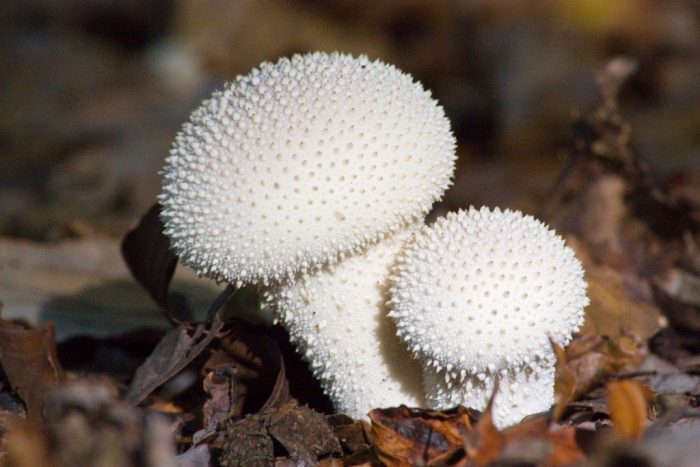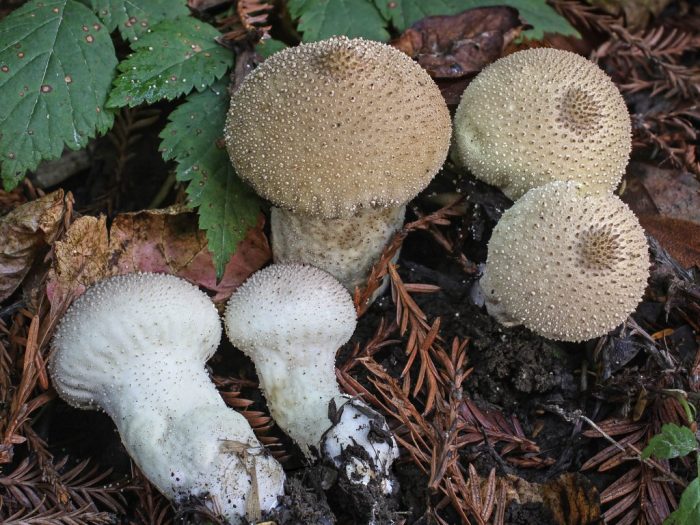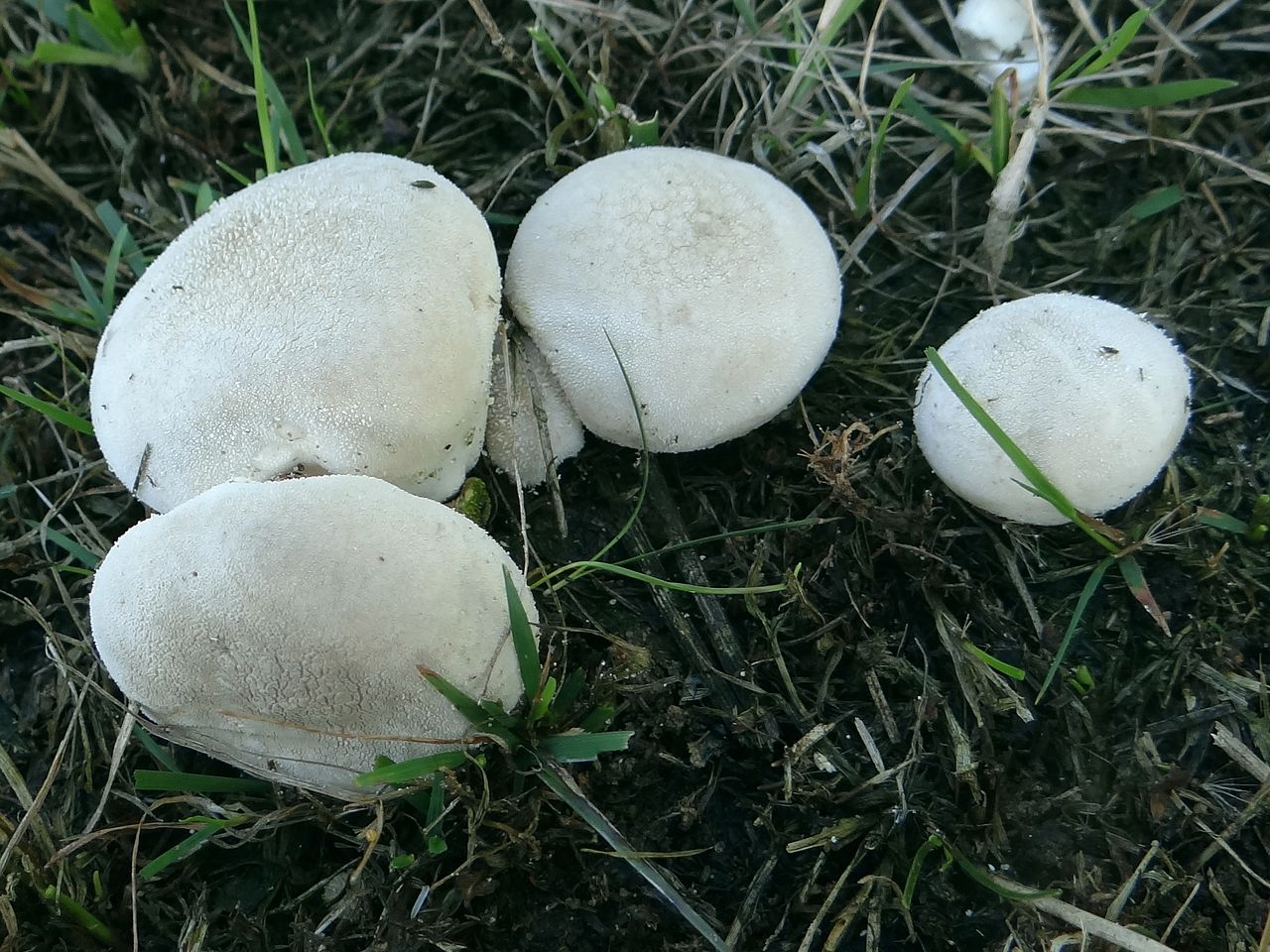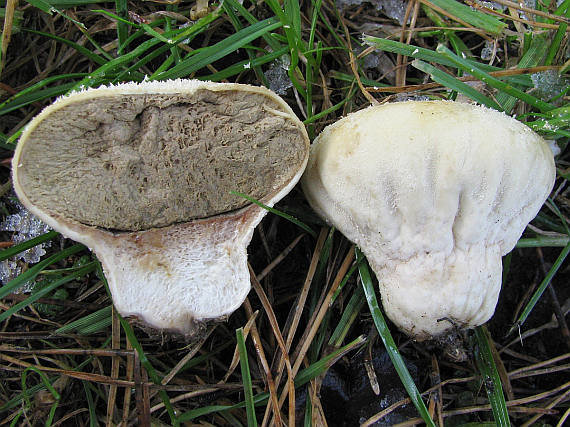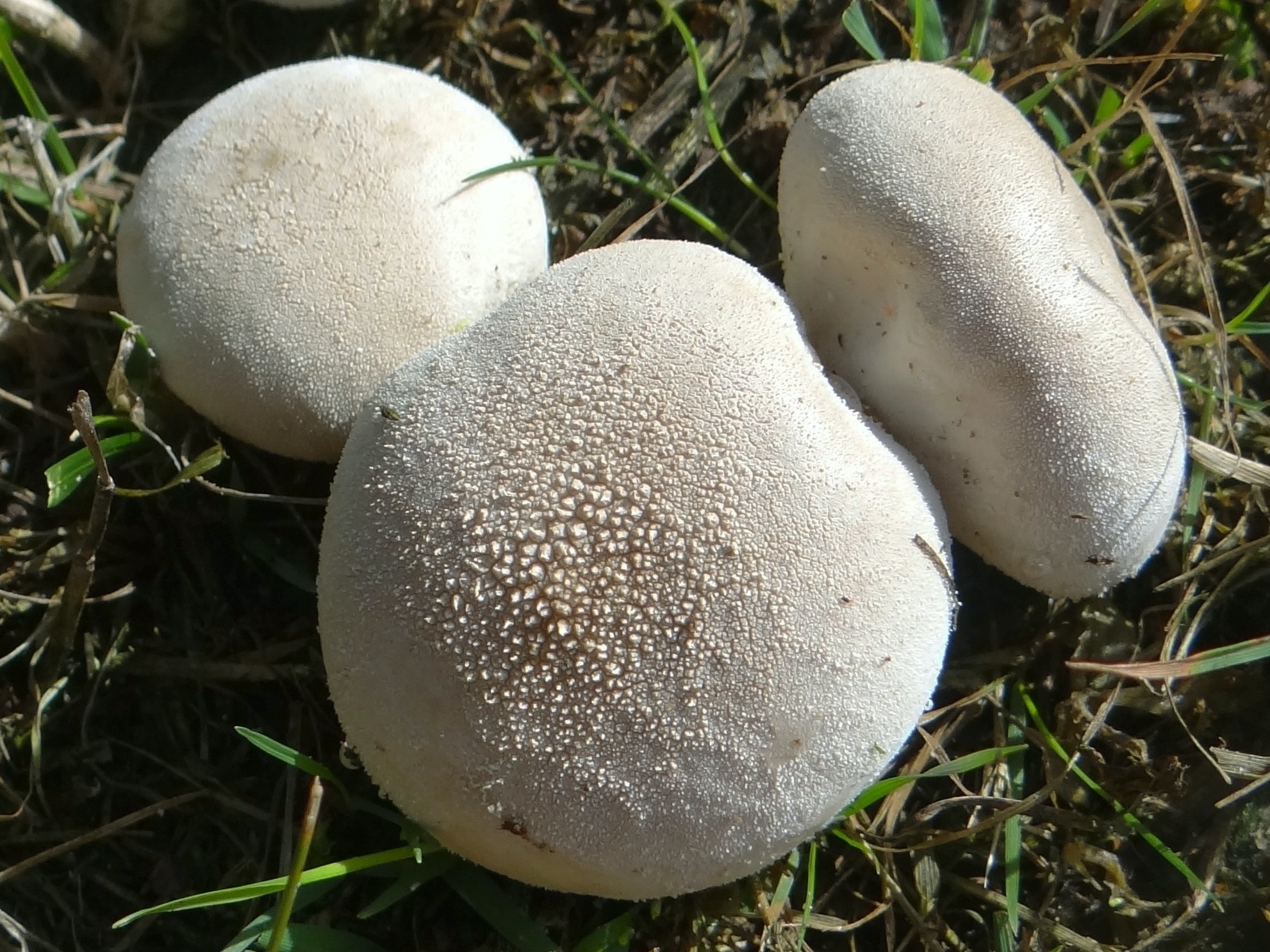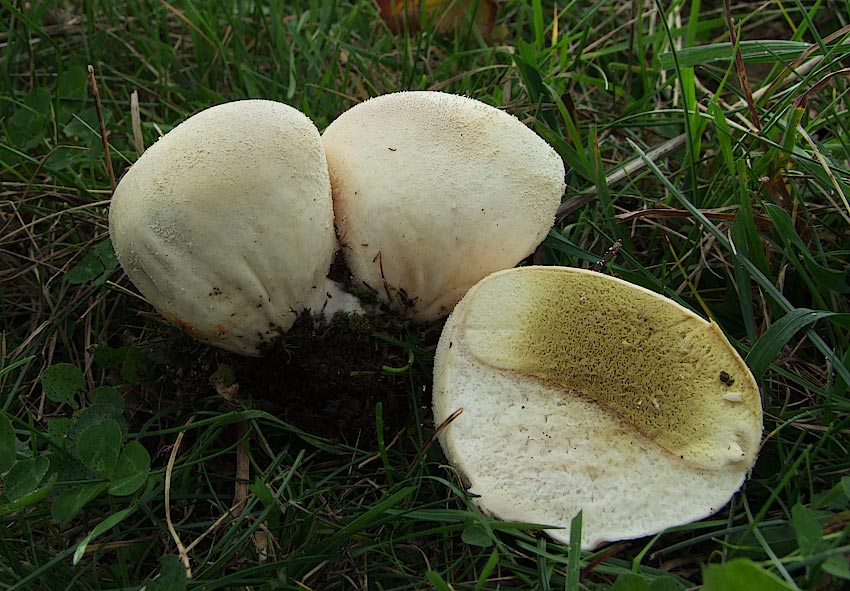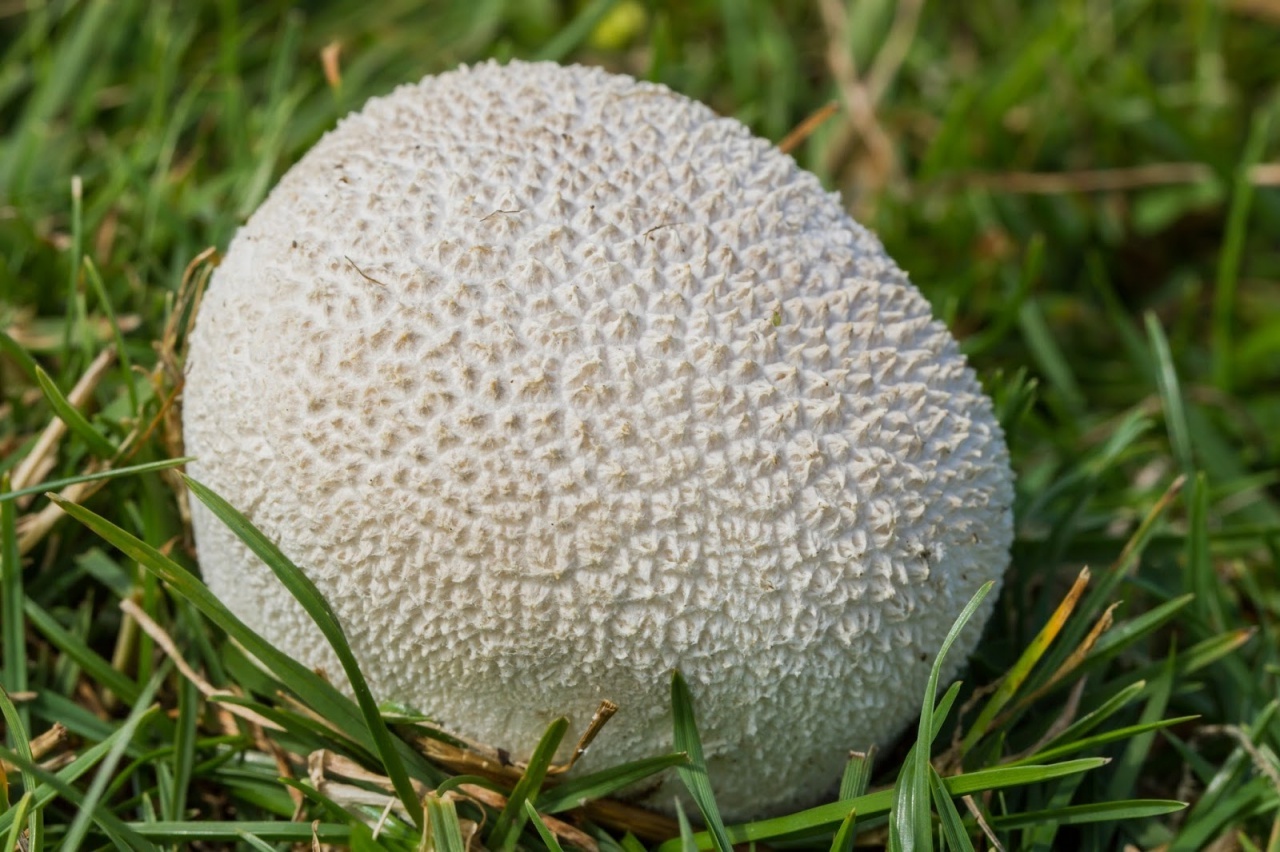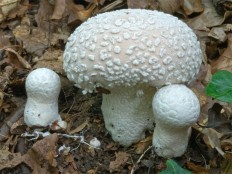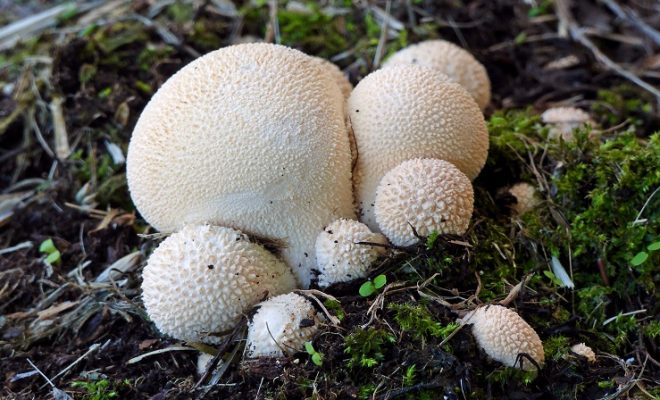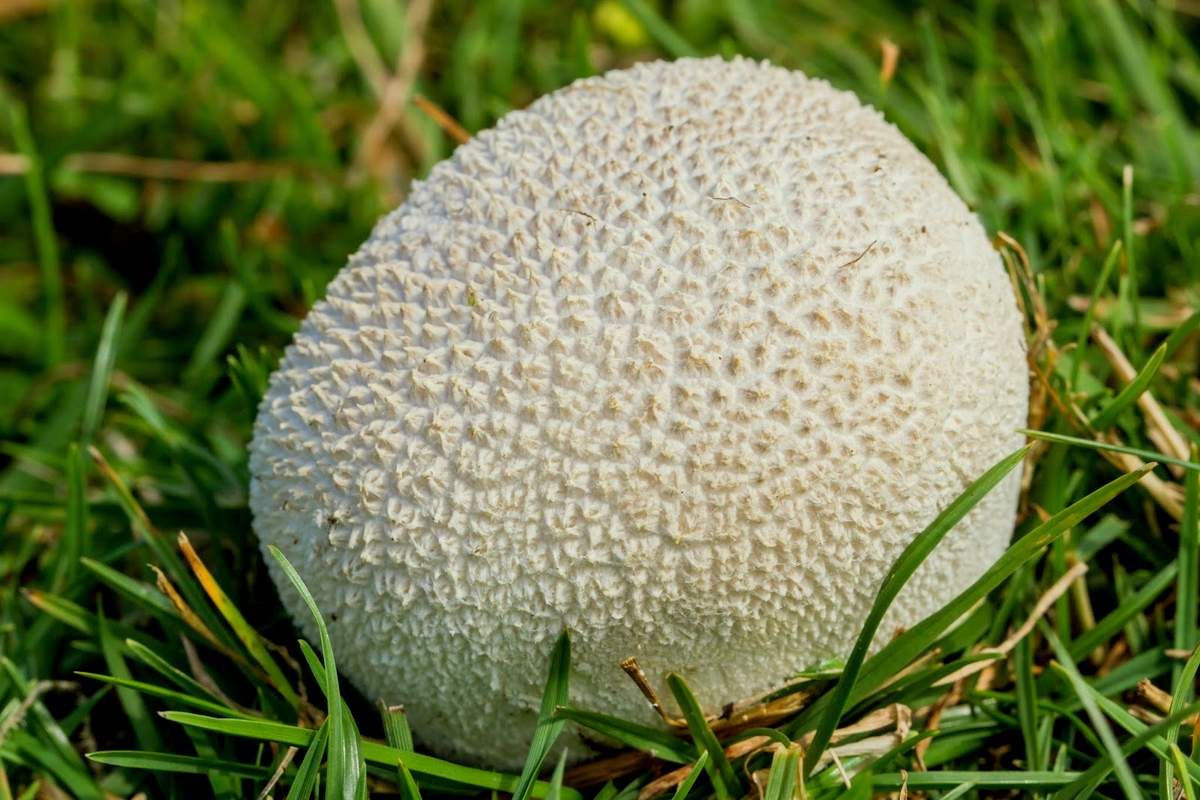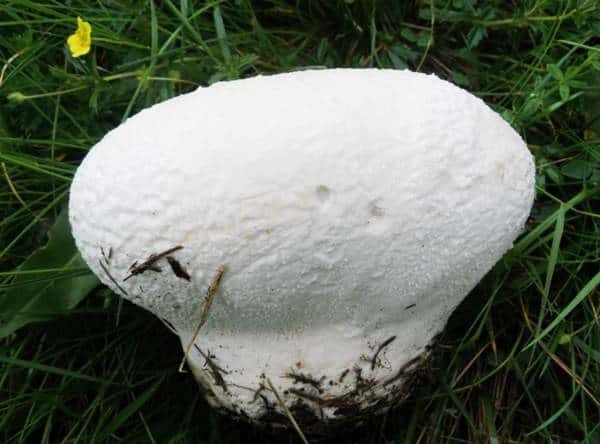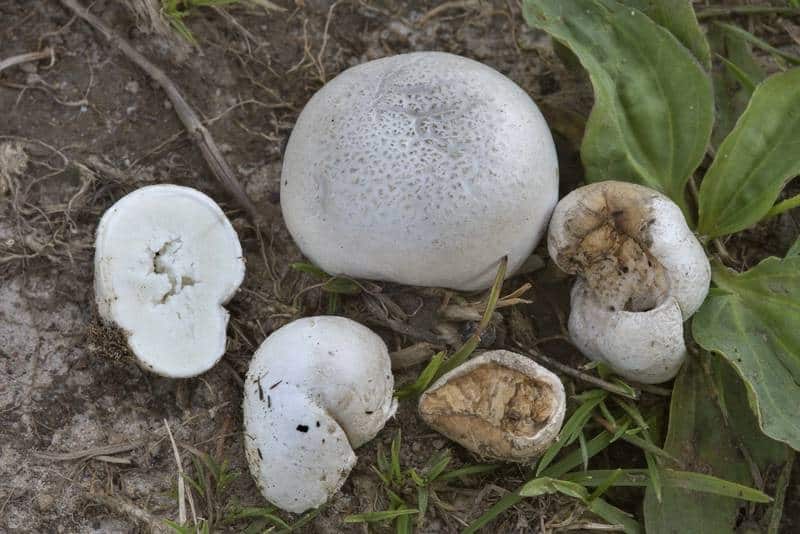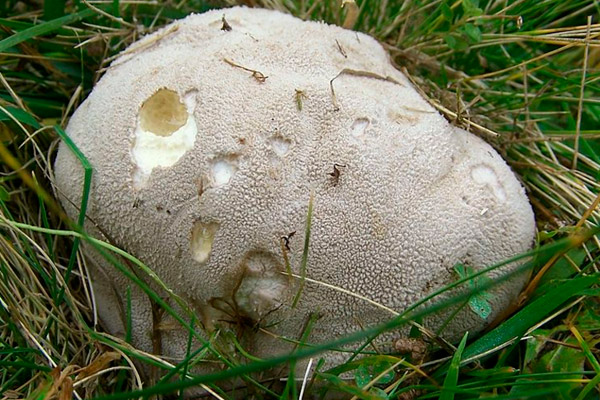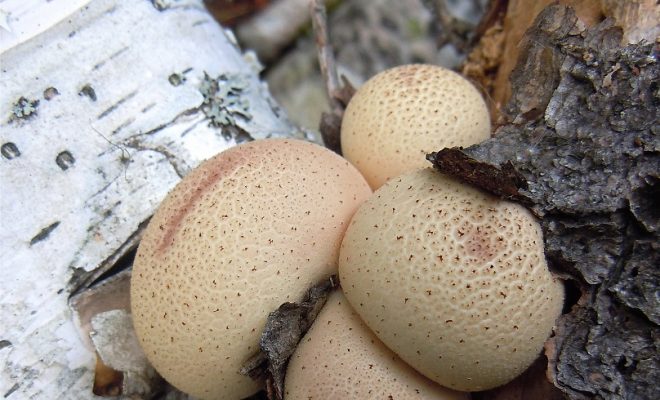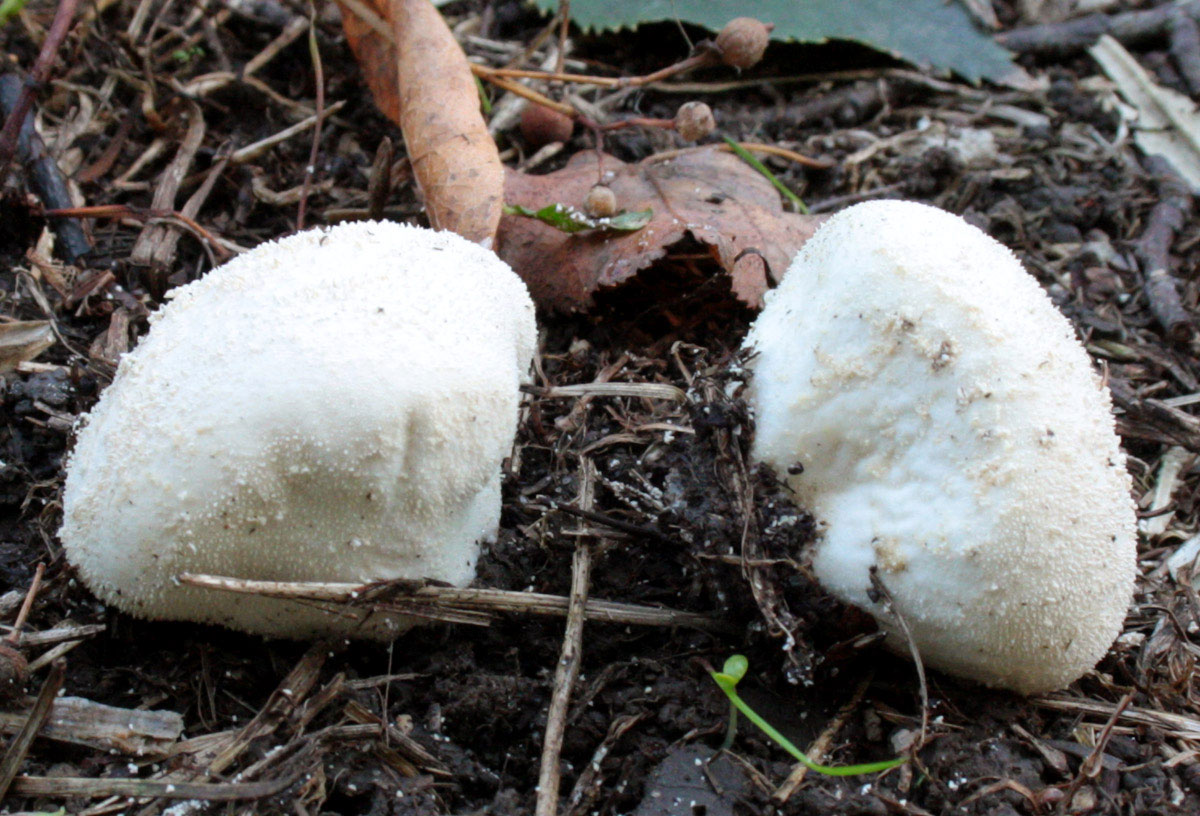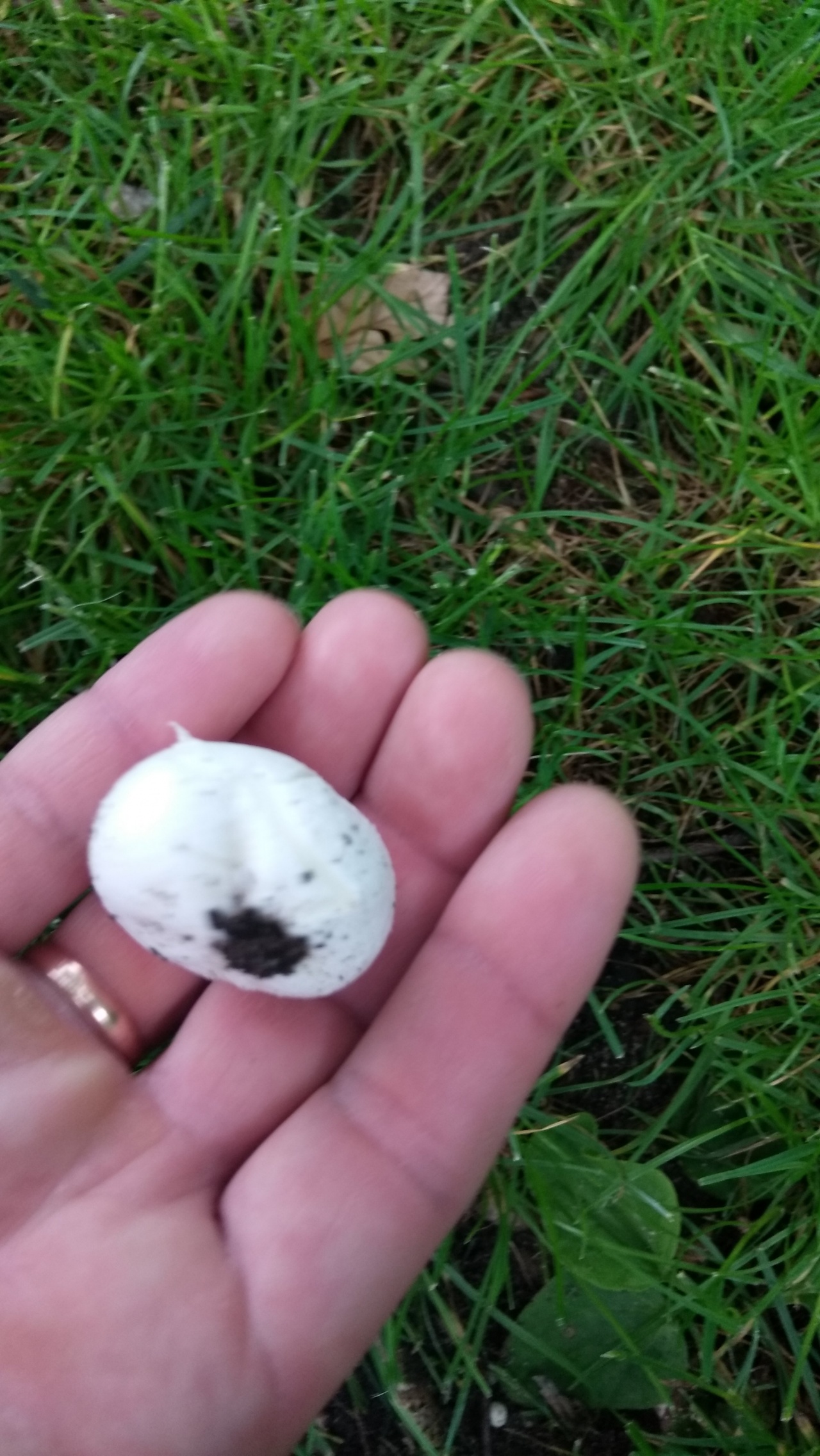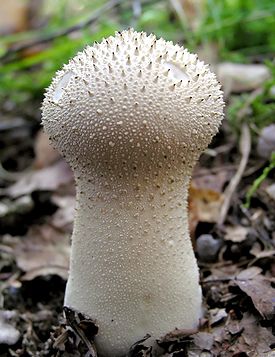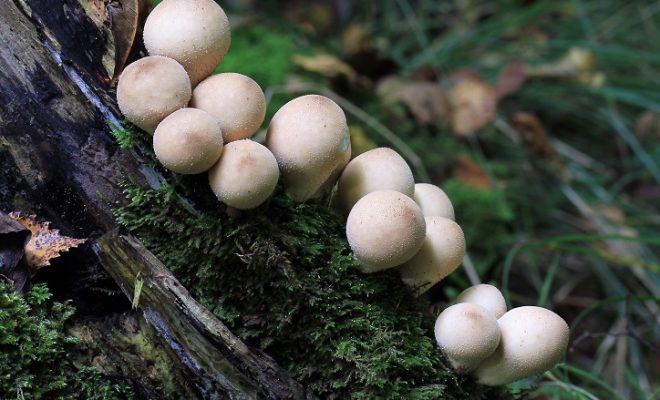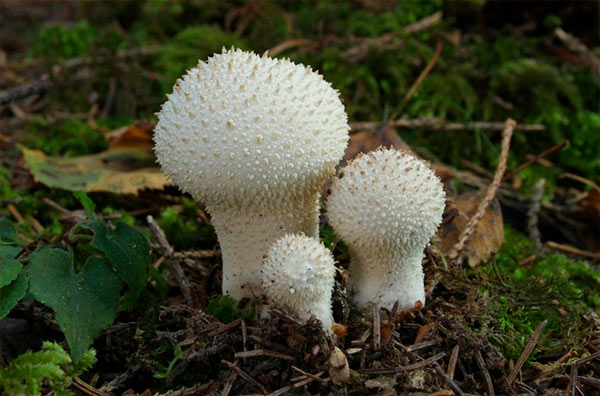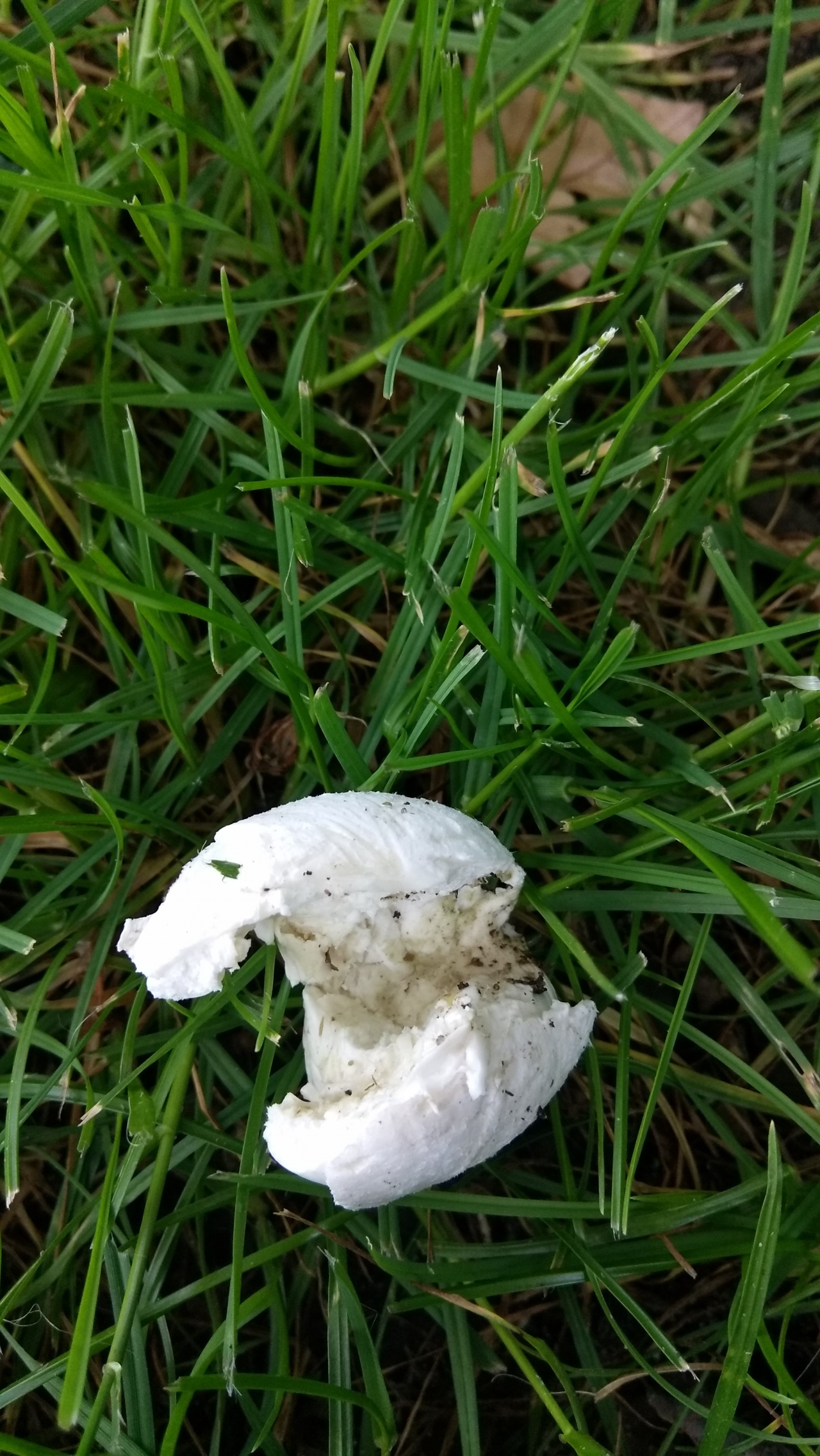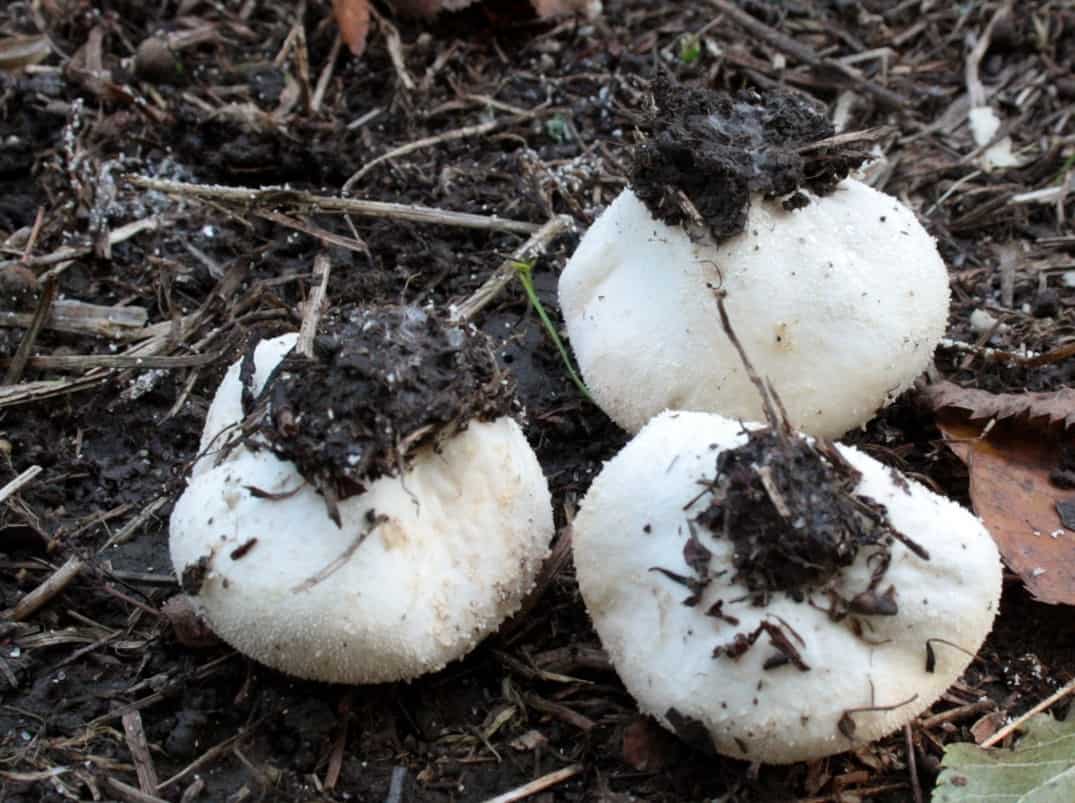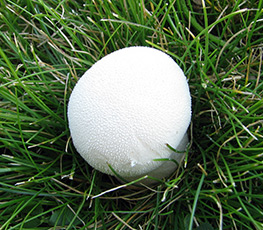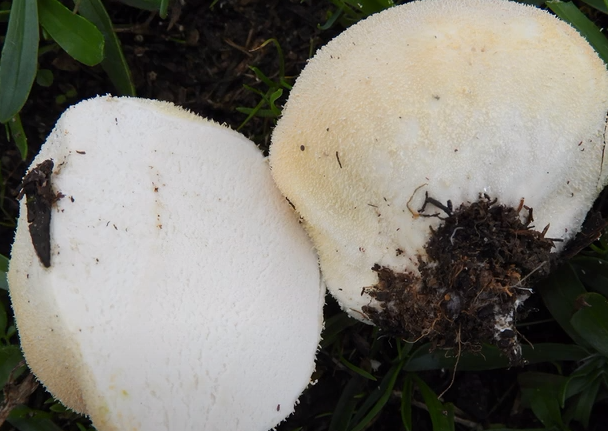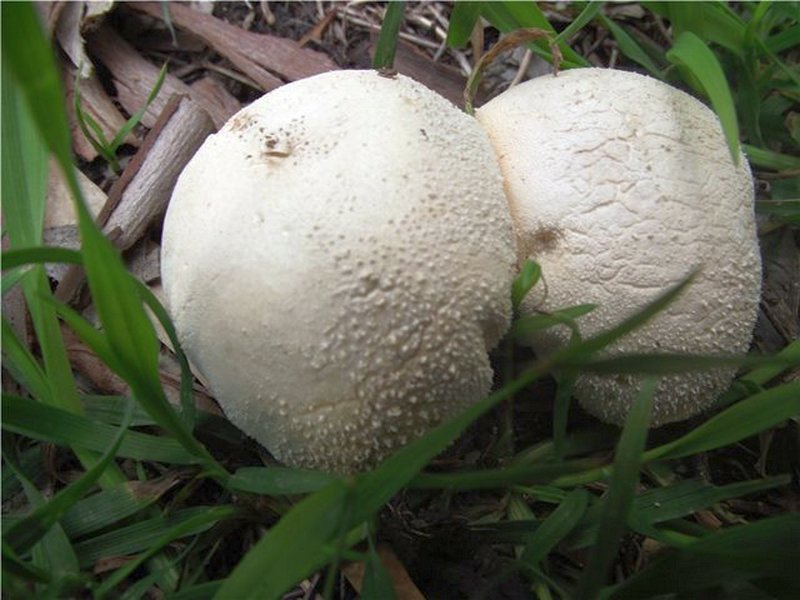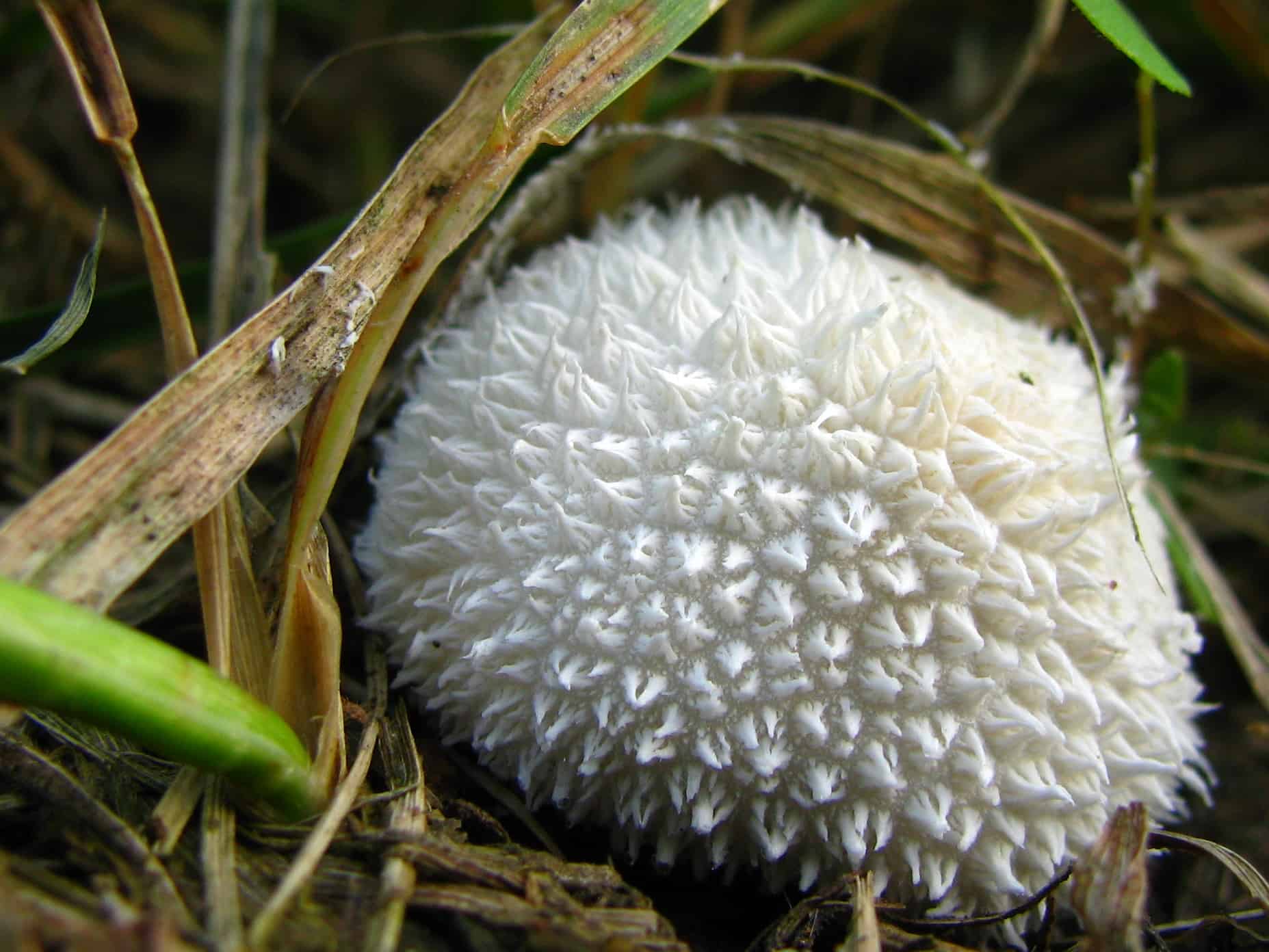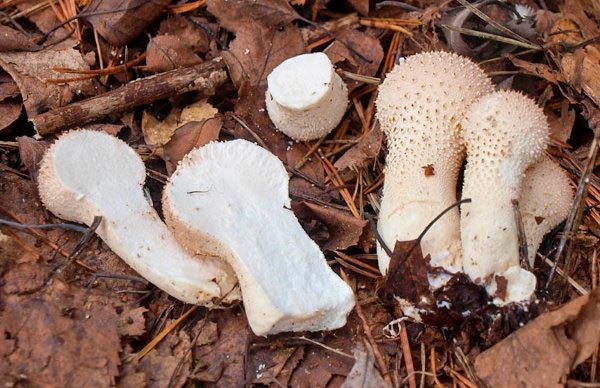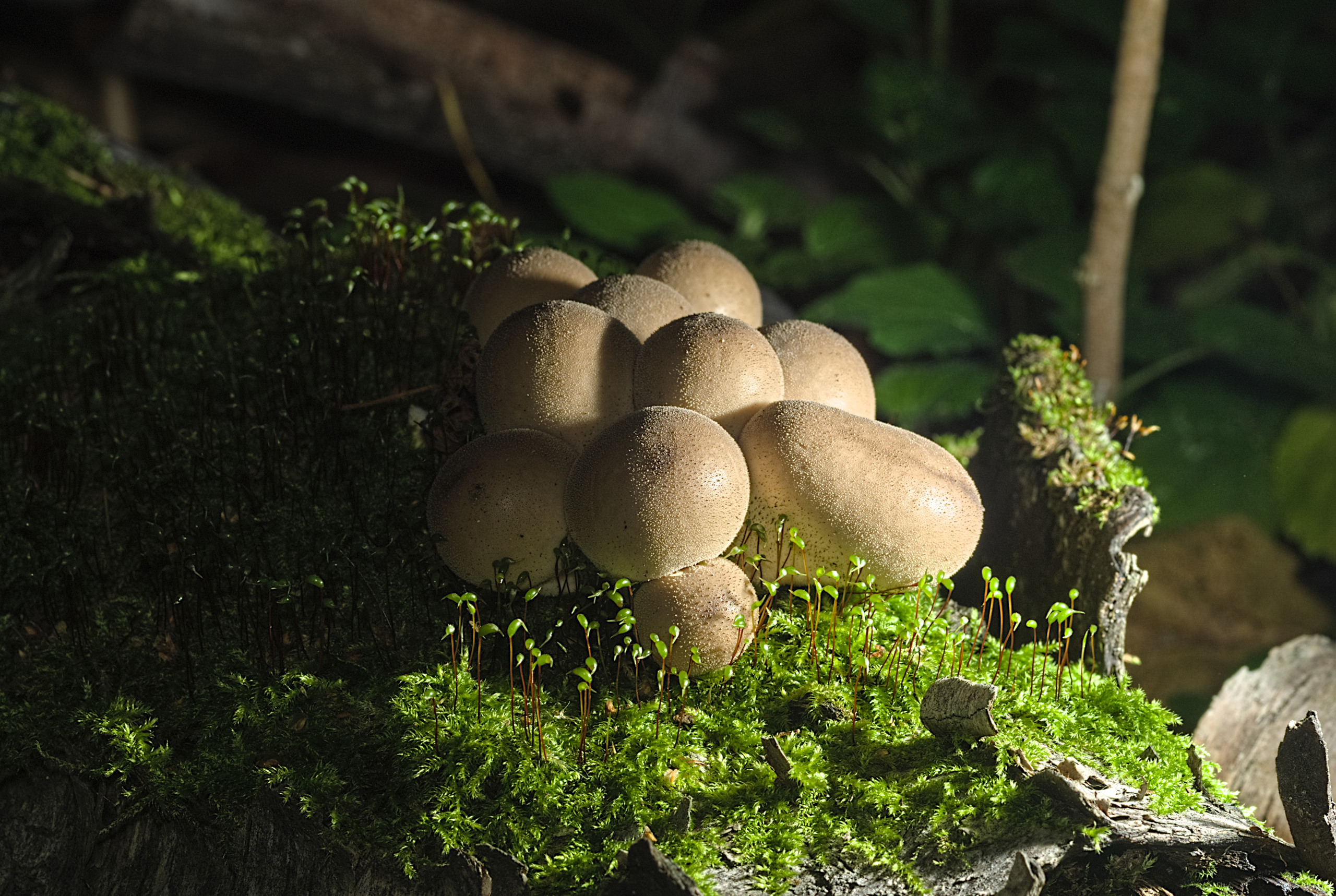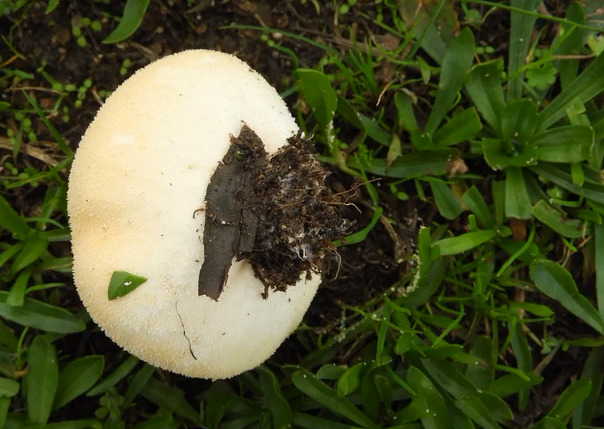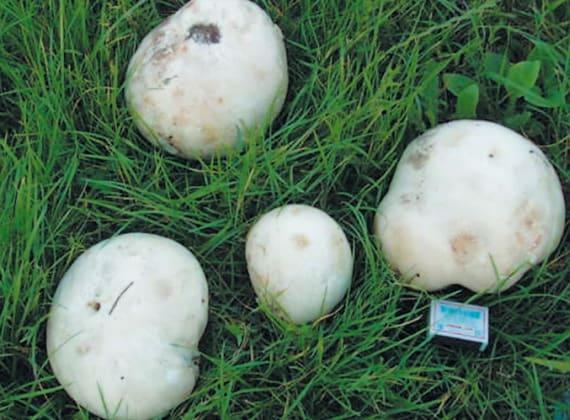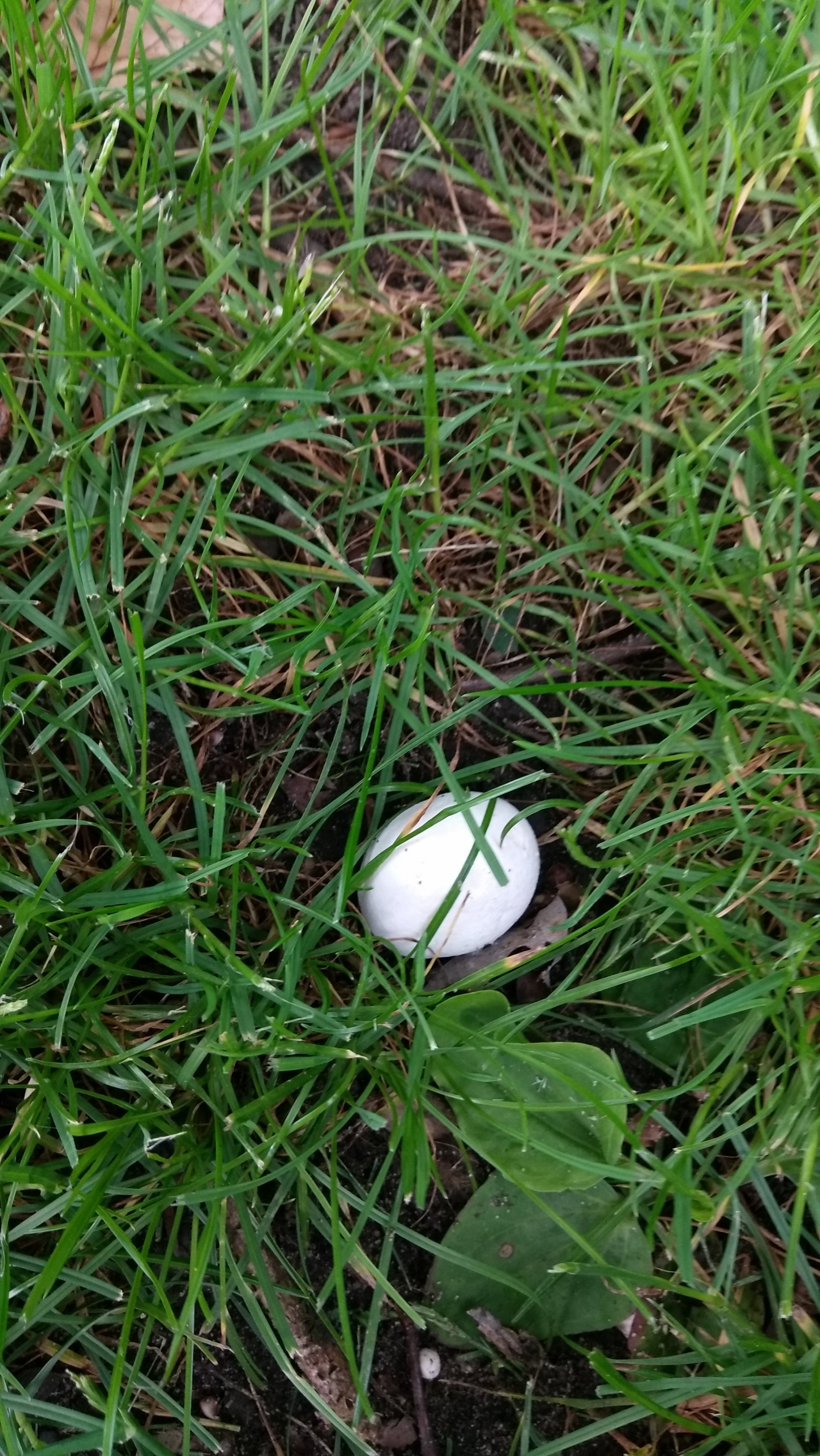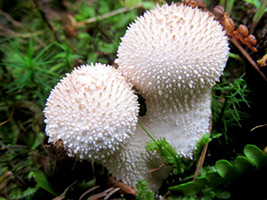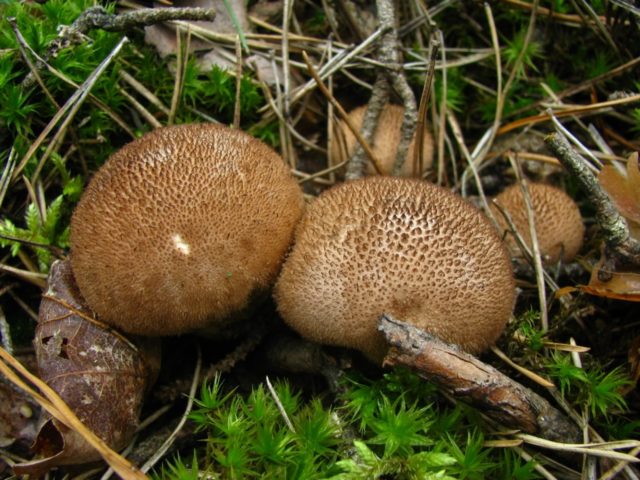Description of the meadow raincoat
The diameter of the cap of a meadow raincoat ranges from 2 to 5 centimeters. The shape of the mushroom is spherical with a slightly flattened top. The color of the fruiting body is white or light brown. The pulp is firm, soft, very tasty and juicy. As it grows, it becomes even softer.
In young mushrooms, the surface of the fungus is mealy, completely covered with small thorns. In the process of growth after rains, the thorns are washed off, the color of the fungus changes to yellowish, and over time it becomes light brown. There is a leathery septum between the leg and the spore area. The leg is slightly thickened. The height of the mushroom does not exceed 1.5-3.5 centimeters.

On the top of the meadow raincoat there is a hole for spores. Spores are olive-gray.
Places of growth of meadow raincoats
These mushrooms grow in fertile soil such as lawns and parks. They are distributed in groups. Meadow raincoats are unpretentious to growing conditions. They grow better in organic areas. The harvest season is June-October.
Eating a meadow raincoat for food
Although these mushrooms are Category 4 in taste, this does not mean that they have a mediocre taste. It was just that this category included mushrooms that were rarely harvested and eaten. Many mushroom pickers say that raincoats are meadow almost as tasty as boletus.

Before preparing a meadow raincoat, you need to find out in what place it grew, since these mushrooms are overly susceptible to toxins, therefore, eating mushrooms that grew in places undergoing toxic processing can get poisoned.
Mushrooms are preliminarily cleaned from the top layer of the skin, since it is tasteless and gives toughness. There is a smell of wood during cooking, but it completely disappears when the mushrooms are ready.

Only young meadow raincoats are suitable for food. Gourmets believe that fried raincoats taste like meat. The best taste is inherent in white raincoats, the skin of which has not yet turned brown, and the dark softness becomes wadded and inedible.
The big advantage of meadow raincoats is that they do not need preliminary preparation before cooking, that is, they do not need to be soaked and boiled, which is typical of many "noble mushrooms". But they are more suitable for frying, but in soups they resemble rubber.
There is one secret of making meadow raincoats - so that mushrooms do not lose their aroma, they are not washed, but cleaned with a dry knife.
Useful properties of a meadow raincoat
Meadow raincoat is not just a tasty mushroom that is suitable for cooking various dishes, but also a remedy that has healing properties. Various medicinal tinctures are made from these mushrooms.

Meadow raincoats have unique wound healing and hemostatic properties, therefore, they treat cuts and wounds with their help. For this, fresh pulp is used.
Meadow raincoats have a similar effect on burns, purulent wounds, ulcers, urticaria, acne, smallpox and the like. In folk medicine, decoctions of these mushrooms are considered an excellent remedy for laryngitis, bronchitis and even tuberculosis.
Mature meadow raincoats help get rid of aphids. For this, spores are set on fire and trees and bushes are fumigated with smoke.
Features of harvesting a meadow raincoat
It should be borne in mind that these mushrooms very quickly lose their whiteness and become inedible, and this happens even immediately after harvest. Therefore, for long-term storage, they must be harvested in a special way. They are cut into thin, almost transparent slices and dried quickly.

If it is not possible to immediately cook the harvested mushrooms, they are boiled, in this case the ripening process stops.After that, they can be fried as much as possible.
Similar species
Some types of raincoats are considered conditionally edible or inedible. For example, a raincoat is brown, soft, black, small, and the like. These species are much less common in comparison with the meadow raincoat. It is in this connection that their edibility has not been fully studied.
Some types of raincoats are classified as inedible because of their ugly appearance or unpleasant taste. For example, the surface of a black raincoat is strewn with dark thorns, and a small raincoat is covered with scales.

Black raincoat
In theory, eating only the white pulp of raincoats will not lead to poisoning. But, nevertheless, their taste will not be so good, therefore, when collecting, it is better to give preference to meadow raincoats with a light color.
Cucumbers, pickled in jars or enamel dishes
An interesting view of pickling cucumbers is expressed in the book from the series "Encyclopedia of Country Life". The author writes:
If you plan to store pickled cucumbers not in the basement or refrigerator, it is recommended to divide the pickling process into 2 stages: cooking salted cucumbers and rolling.
At the 1st stage, it is recommended to: rinse the cucumbers well, cover with cold water and soak for at least 2 hours. And if the time for picking cucumbers is unknown, the soaking time should be increased to 4 hours. While the cucumbers are soaking, prepare the brine.
At the 2nd stage, ready-made salted cucumbers are rolled up in jars, according to recipes. There are also a lot of them in the book. We will not describe all of them here, since in this article we are only interested in soaking time.
Characteristics of individual species
All raincoats have peculiar fruiting bodies, not similar to the appearance of other mushrooms. Their bodies are, as it were, closed in an oval, pear-shaped, spherical, capitate shape with a cylindrical leg. I have an association with an egg in a shell or "a pig in a poke" (just kidding!).
Depending on the type, it has different weights and dimensions.
Pearl raincoat Lycoperdon perlatum, real or prickly, warty.
The nicest and cutest. Often found in coniferous and less often deciduous forests, on soil, rotten wood. He loves moisture, so he is found near swamps, but closer to the forest edge. The cap of the mushroom without separation by anything smoothly turns into a thick cylindrical stem. The height of the pearl is up to 15 cm, but this is rare. The diameter and height of the head are up to 4 cm. Basically, the dimensions are more modest, two to three times. Near our swamp, I found just large raincoats, only two, very dense and resilient. They often grow in small groups. Growth time from early July to late September.
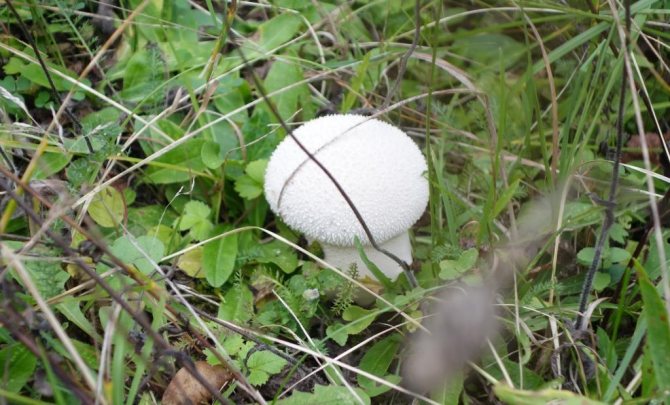
The whole body of the pearl slicker is covered with a shell, outside of which there are spines or warts. When touched with a hand, they easily crumble.
The shell and flesh (gleb) of the young mushroom are pure white, like the thorns. (see photo):

With age, the color changes to olive, the fruiting body dries out, and the spore powder ripens in the head. The shell of the raincoat grows decrepit, and a hole forms at the top of the cap; through it, a huge number of disputes are released. The effect of this release is similar to brown smoke, hence the "tobacco" names for the mushroom.
Pear-shaped raincoat.
It grows especially in old clearings, at the bases of stumps and trunks of dead trees in any forests, in large groups, especially after heavy rains.
The fruiting body is pear-shaped, ovoid, there is a barely noticeable false stem below. Height up to 5 cm, maximum diameter - 5 cm. The shell is white or grayish, easy to clean, like the shell of a boiled egg. Like a pearl, but smaller, covered with thorns. When the mushroom matures, its surface becomes smooth and reticulate, as if it could crack like dry.
The process of spore formation is similar to that described above.
Giant raincoat or bighead (round, oblong)
The size of the gleba (pulp) is up to half a meter in diameter, often flattened.Prefers deciduous forests, but more willingly settles on abandoned pastures and fields. Therefore, probably, I have never met them in our conifers.
The shell is very thin, smooth; at first, like the flesh, it is white, then greenish-yellow.
Umber or brown
It is similar to pear-shaped, but has a large number of larger needles, gray-brownish. The leg is folded, almost invisible, the maximum size of the mushroom is 6 cm in diameter.
In the photo, the mushroom is grandfather's pearl tobacco:
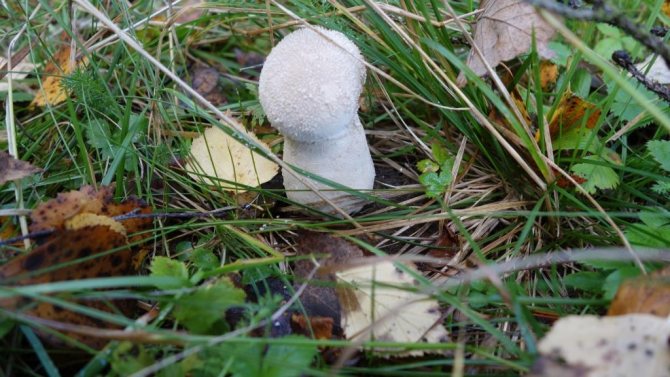
Once we traveled along the coast of our Mountain Sea. We were running out of provisions, but we were saved by a clearing with raincoats. The top shell is easy to peel, while the white pulp looks appetizing and is nice to cut. Mushrooms are nutritious, tasty, aromatic. We then fried a whole skillet, adding russula to them.
In deciduous and coniferous forests, along roads and edges, from August to September, you can find a false raincoat. It is distinguished by a smooth or finely scaly shell of a dirty yellow-brown color. It is thick and dense, leathery. The pulp inside is dark purple with white veins. There are no legs, and the diameter does not exceed 6 cm. It has the smell of raw potatoes. In food, it is practically used only to give a dish a specific smell.
Harm and contraindications
For the use of mushrooms for food or for use for medicinal purposes, it is forbidden to collect them along busy highways and in areas with an unfavorable ecological state, as this is fraught with poisoning.
A contraindication to use is also:
- pregnancy;
- lactation;
- childhood;
- individual intolerance;
- renal failure.
It is recommended to start treatment with the minimum doses and, if there are no negative manifestations, continue taking in the indicated dosages.
This product does not harm the body and does not possess poisonous analogues. But still, how to distinguish from a poisonous mushroom? Before consuming or using for cosmetic or medicinal purposes, you need to remember that these are the most useful and tasty young mushroom specimens with white, tender and dense pulp.
The product is not allowed for use by children and adolescents, women during lactation and pregnancy, people in deep old age, with gastrointestinal diseases (very difficult to digest).
Smelly raincoat: photo and description
| Name: | Smelly raincoat |
| Latin name: | Lycoperdon nigrescens |
| Type of: | Inedible |
| Synonyms: | Lycoperdon foetidum, Lycoperdon montanum |
| Specifications: |
|
| Systematics: |
|
The smelly raincoat is a common species of the Champignon family. Its characteristic feature is the dark color of the fruiting body and curved thorns on the surface. In addition, the mushroom exudes a peculiar smell, reminiscent of luminescent gas, for which it received its name. In official reference books it is listed as Lycoperdon nigrescens or Lycoperdon montanum.
Description of the smelly raincoat
It is characterized by a non-standard shape of the fruiting body, therefore, the cap and leg of the smelly raincoat are a single whole. The surface is brown and densely covered with drooping thorns that fit tightly to each other, and thus form star-shaped clusters. The shade of the outgrowths is much darker than the main tone.
The smelly raincoat has a pear-shaped reverse shape, narrowed downward. The upper part is thickened, reaches 1-3 cm in diameter. The height is 1.5-5 cm. When ripe, thorns fall off the surface, leaving a light cellular pattern on a brown background. When ripe, a small hole appears at the apex through which the spores come out.
Outwardly, a smelly raincoat resembles a fleecy bump
The flesh of young specimens is white and firm. Subsequently, it acquires an olive brown hue, which indicates the maturation of the spores. The lower part is elongated and narrowed and resembles a leg. The spores of this species are spherical brown, their size is 4-5 microns.
Where and how it grows
This mushroom can be found in coniferous and mixed forests. It grows mainly in groups near spruce trees. It can sometimes be found in deciduous plantings, which is extremely rare. Prefers soils rich in organic matter and with an increased level of acidity.
Distributed in Europe and Central Russia.
Is the mushroom edible or not
A smelly raincoat is inedible. It must not be eaten fresh or processed. Even young specimens with light flesh are unsuitable for food, unlike other relatives of this family. However, given the characteristic smell of the mushroom, it is unlikely that anyone would think of collecting it.
Doubles and their differences
This mushroom is similar to other members of its family. To be able to distinguish between them, it is necessary to study the characteristic features.
- Pearl raincoat. The fruit body of young specimens is warty, light in color. The thorns are straight and elongated. As it matures, the surface becomes bare and becomes brown-ocher. In addition, the pulp has a pleasant smell. This species is considered edible, however, only young specimens should be collected. Its official name is Lycoperdon perlatum.
Due to its snow-white color, it is not difficult to find this species in the forest.
This twin is distinguished by elongated spines that resemble hedgehog needles.
Conclusion
A smelly raincoat is not of interest to mushroom pickers. This species deserves attention due to the unusual shape of the fruit body. It will not be difficult to distinguish it from edible relatives due to its repulsive smell.
Thorny raincoat, Lycoperdon perlatum
Fruit body: Hemispherical, usually with a noticeable pseudopod. The diameter of the spherical part is 2-4 cm, the legs are 1-2 cm, the height of the fruiting body is 5-7 cm. A characteristic tubercle is often distinguished in the upper part. Color - white in youth, darkens with age to grayish-brown. The skin is covered with easily detachable thorns of various sizes. The pulp is initially white, firm, with a faint pleasant smell, then, as it ripens, it becomes yellow and flabby, and then brown. Ripe spores fly out through a hole in the upper part of the fruiting body.
Spore powder: Brown.
Spreading: Lycoperdon perlatum grows from mid or late May to late autumn (although it is found en masse, as a rule, only in August-September), in coniferous and mixed forests, on forest edges, less often in meadows, at favorable times - in large groups.
Similar species: According to signs, in a formal sense, a prickly raincoat cannot be called some kind of special, recognizable mushroom. At a young age, all raincoats and bigheads, which have a prickly surface of the fruiting body, are somewhat similar to each other. However, even in youth, the bighead is oblong, Calvatia excipuliformis is much larger. In a practical sense, it is not scary to confuse raincoats: their consumer qualities are exactly the same.
Edibility: While the mushroom is fresh, with white elastic flesh, it is quite edible, like all our other raincoats, but it does not differ in its special taste. Raincoats do not withstand long-term storage in a basket - if you are going to spend a few more hours in the forest, and even more so in wet weather, there is no point in taking them: you will bring home a few wet rags, and all other mushrooms will be densely covered with white spines.
Author's notes: At first glance, raincoats are not serious mushrooms. Indeed, not everyone would think of collecting these white balls when the forest is full of other prey, especially since the prickly raincoat bears fruit en masse just along with the white, summer mushroom, boletus.But there is a special whim in going out after dinner for a walk in the woods with the dog, and bringing home full pockets of thick, velvet raincoats. These will not be the raincoats we scrape from the bottom of the basket from time to time after a long hike! These mushrooms can be peeled in three minutes, thrown into a pan and fried in oil, and then you can treat everyone for a long time, because, whatever one may say, a fried raincoat is not for everybody, yes, for everybody.
The following should also be noted. Many authors mention that the pulp of a raincoat has hemostatic properties. Perhaps this information can be useful to someone. But, to be honest, I don't even want to think about a situation in which I have to stop the blood with raincoats.
"There should be a lot of good raincoats." Unlike its close relatives, the thorny raincoat (or, as it is sometimes called, the real raincoat) grows on the soil, neglecting rotting stumps.
Useful properties and contraindications
The raincoat has long been used not only in folk, but also in official medicine for its medicinal properties.
It contains:
The pulp of the mushroom contains amino acids:
Beneficial features:
- improves the cardiovascular system;
- cleanses the body and removes radionuclides, toxins;
- enhances immunity;
- hemostatic;
- differs in antitumor properties;
- improves metabolic processes of the body;
- has a beneficial effect on the skin, making it firm and healthy.
Broths and infusions from young fruit bodies are used:
- at the hanged temperature;
- with high pressure, angina pectoris;
- to relieve inflammation, for example, with throat bumps, chronic tonsillitis or severe pain in the kidneys;
- to reduce hemoglobin;
- to inhibit the growth of malignant tumors and the progression of leukemia;
Not recommended for pregnant and lactating women and children under 5 years of age
Take with caution in diseases of the pancreas, kidneys and exacerbation of diseases of the gastrointestinal tract. You should not pick mushrooms in an area with poor ecology, near factories and highways, as they can contain toxins and pose a health hazard
Useful properties of the raincoat mushroom
You can endlessly talk about the beneficial properties of a seemingly inconspicuous raincoat, and if mushroom pickers know incredibly little about it and constantly ask themselves whether it is edible or not, then for doctors it is quite famous, as it has incredible healing properties.
This plant is able to remove from the body excess chloride and fluorine compounds, radionuclides, which adversely affect the functioning of the thyroid gland.
The raincoat mushroom is not only tasty, but also useful, and the presence of valuable components ensures its medicinal properties:
- Calvacin fights and rid the body of pathogenic bacteria and fungi, reduces the risk of developing tumors, inhibits the growth of malignant and benign tumors.
- Ergosterol helps with venous congestion, eczema and digestive problems.
- The properties of the dust collector are used to treat fibroids, diseases of the thyroid gland and kidneys.
- The pulp of the mushrooms helps to disinfect wounds and has hemostatic and wound healing effects, the same effects are possessed by the leaves of the wintergreen.
- The dust collector has the ability to remove radionuclides, fluorinated, chlorine-containing substances and toxins from the body.
Preparations based on them have healing properties and are capable of:
- improve immunity;
- update the composition of lymph and blood;
- cleanse the body. Guava also has the ability to cleanse the body, due to the high content of pectin;
- improve the digestive tract and fight against dysbiosis. The pear has the same beneficial properties, they are introduced into medical nutrition for disorders of the gastrointestinal tract, especially if it is associated with microflora;
- relieve inflammation and fever;
- suppress the development of cancerous tumors.
Thorny raincoat (Lycoperdon perlatum)
- Other names for the mushroom:
- Edible raincoat
- The raincoat is real
- Pearl raincoat
Synonyms:

Usually, the actual raincoat is called young dense mushrooms, which have not yet formed a powdery mass of spores ("dust"). They are also called: bee sponge, hare potatoes, and a ripe mushroom - flap, puff, dust collector, grandfather's tobacco, wolf tobacco, tobacco mushroom, damn tavlinka, and so on.
Fruit body:
The fruiting body of raincoats is pear-shaped or club-shaped. The fruit spherical part is 20 to 50 mm in diameter. The lower cylindrical part, sterile, 20 to 60 mm high and 12 to 22 mm thick. In a young mushroom, the fruit body is prickly-warty, white. In mature mushrooms, it becomes brown, ocher and naked. In young fruiting bodies, Gleb is elastic and white. The puffball differs from the cap mushrooms in a spherical fruiting body.
The fruit body is covered with a two-layer shell. Outside, the shell is smooth, inside - leathery. The surface of the fruiting body of the present slicker is covered with small thorns, which distinguishes the mushroom from the pear-shaped slicker, which at a young age have the same white color as the mushroom itself. The spikes are very easily detached at the slightest touch.
After drying and ripening of the fruit body, white Gleb turns into an olive-brown spore powder. The powder comes out through the hole formed in the apex of the spherical part of the mushroom.

Leg:
A prickly raincoat can be with or without a barely perceptible leg.
Pulp:
in young raincoats, the body is loose, white. Young mushrooms are good for consumption. Mature mushrooms have a powdery body, brown in color. Mushroom pickers call mature raincoats "damn tobacco." Old Raincoats are not eaten.
Disputes:
warty, spherical, light olive brown.
Spreading:
The prickly raincoat is found in coniferous and deciduous forests from June to November.
Edibility:
Little known edible delicious mushroom. Raincoats and dust covers are edible until they lose their whiteness. They eat young fruit bodies, the Gleb of which is elastic and white. It is best to fry this mushroom, cutting it into slices beforehand.
Similarity:
The prickly raincoat outwardly resembles the Oblong Golovach, which has the same pear-shaped and club-shaped fruiting body. But, unlike a real raincoat, a hole does not form on its top, but the entire upper part disintegrates, after the disintegration only a sterile leg remains. And all the other signs are very similar, Gleb is also dense and white at first. With age, Gleb turns into a dark brown spore powder. Golovach is prepared in the same way as a raincoat.

Notes:
These mushrooms are familiar to everyone, but almost no one picks them. When you knock off the white balls, brown clouds of smoke rise upward - the spores of these mushrooms scatter. This species was called a raincoat because very often it grows after rains. Until the raincoats inside turned green, these are delicious mushrooms. Italians consider this species to be the tastiest of mushrooms. But when Gleb becomes greenish, the mushroom becomes cottony and tasteless, but not poisonous. Therefore, the harvested mushrooms cannot be stored for a long time, even plucked ones turn green very quickly.


